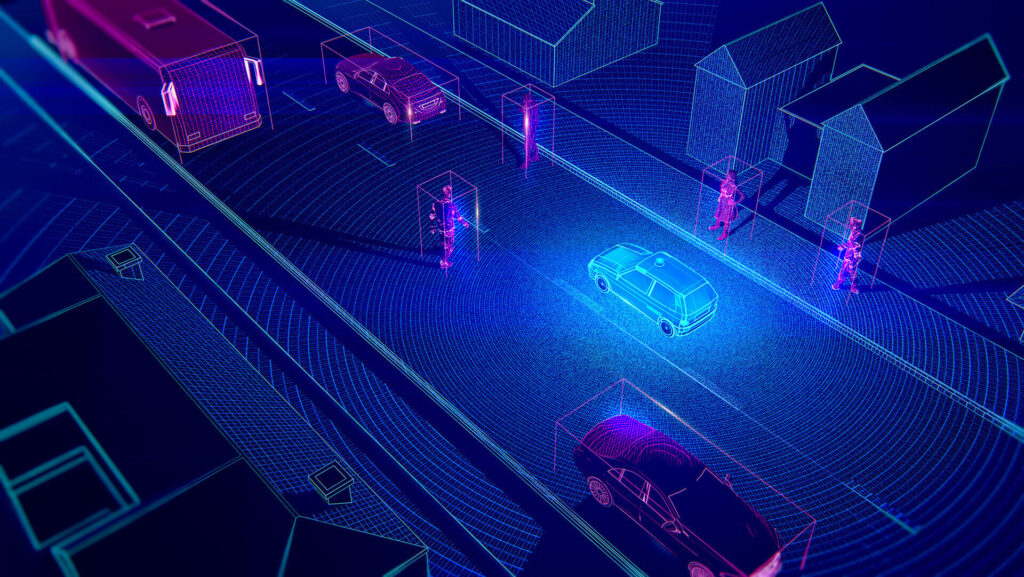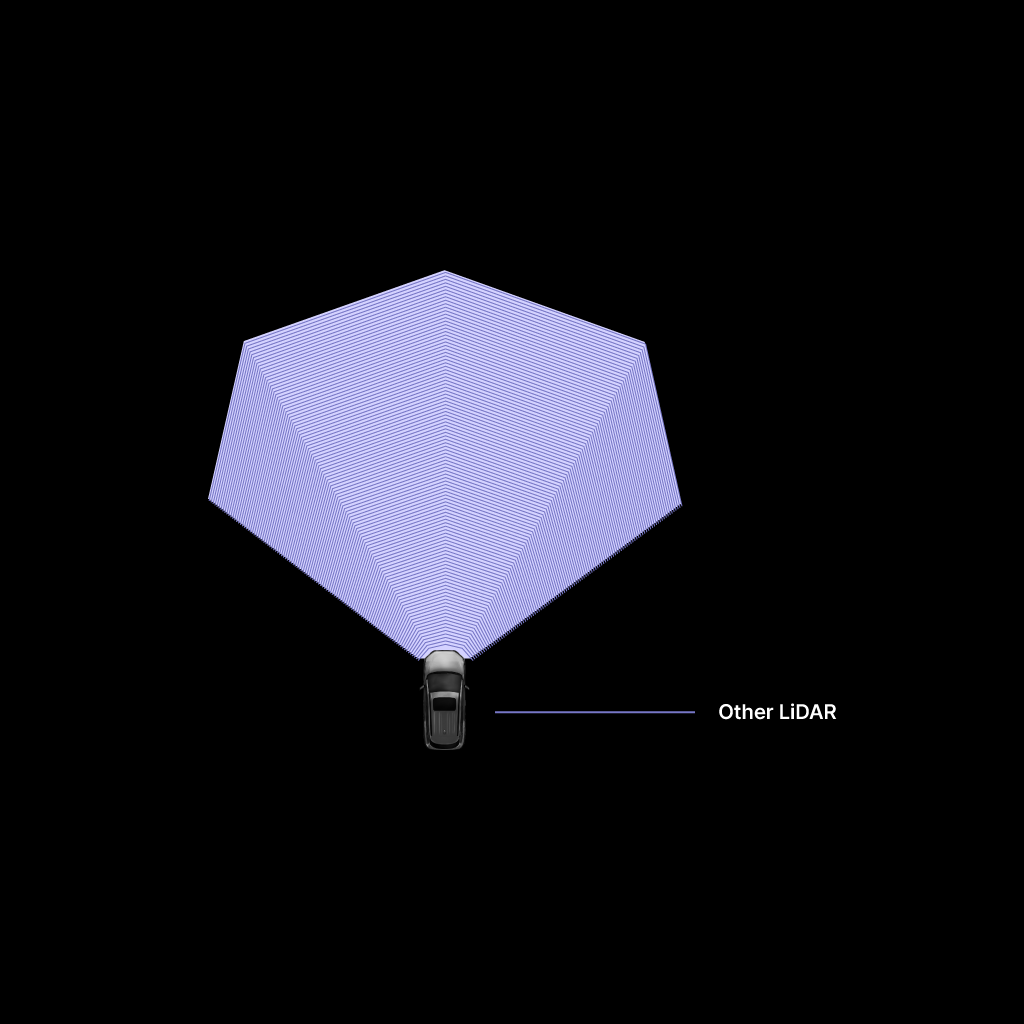TECHNOLOGY
LiDAR Core Technology
Introduction of AutoL’s Innovative Technology
About LiDAR

to measure the time it takes for laser beams to reflect off objects and return,
acquiring distance information.
As a key electronic component for autonomous vehicles,
LiDAR is a three-dimensional spatial information recognition sensor that measures the distances
to various objects in the driving environment at individual points,
recognizing the precise distance and shape of target objects (such as driving obstacles)
as spatial information.
The output data of LiDAR is represented as ‘points’ based on distance,
as shown in the following diagram.
These points come together to form three-dimensional spatial information,
known as a Point Cloud.
Using point cloud data, OEMs and system providers analyze the data
for Object Detection & Classification to develop autonomous driving systems for vehicles.
that uses high-powered pulse lasers to measure the time it takes
for laser beams to reflect off objects and return,
acquiring distance information.
As a key electronic component for autonomous vehicles,
LiDAR is a three-dimensional spatial information recognition sensor
that measures the distances to various objects
in the driving environment at individual points,
recognizing the precise distance and shape of target objects
(such as driving obstacles) as spatial information.
The output data of LiDAR is represented as ‘points’ based on distance,
as shown in the following diagram.
These points come together to form three-dimensional spatial information,
known as a Point Cloud.
Using point cloud data, OEMs and system providers analyze the data
for Object Detection & Classification
to develop autonomous driving systems for vehicles.

LiDAR (Light Detection and Ranging)
is a device that uses high-powered pulse lasers to measure the time it takes for laser beams to reflect off objects and return, acquiring distance information.
As a key electronic component for autonomous vehicles, LiDAR is a three-dimensional spatial information recognition sensor that measures the distances to various objects in the driving environment at individual points,
recognizing the precise distance and shape of target objects (such as driving obstacles) as spatial information.
The output data of LiDAR is represented as ‘points’ based on distance, as shown in the following diagram.
These points come together to form three-dimensional spatial information,
known as a Point Cloud.
Using point cloud data, OEMs and system providers analyze the data
for
Object Detection & Classification to develop autonomous driving systems for vehicles.
is a device that uses high-powered
pulse lasers to measure the time
it takes for laser beams to reflect off
objects and return, acquiring
distance information.
As a key electronic component
for autonomous vehicles,
LiDAR is a three-dimensional
spatial information recognition
sensor that measures the
distances to various objects
in the driving environment at individual
points, recognizing the precise distance
and shape of target objects
(such as driving obstacles)
as spatial information.
The output data of LiDAR
is represented as ‘points’ based on
distance, as shown in the following
diagram. These points come together
to form three-dimensional spatial
information, known as a Point Cloud.
Using point cloud data,
OEMs and system providers
analyze the data
for Object Detection & Classification
to develop autonomous driving
systems for vehicles.




High-resolution LiDAR with 32 or more channels is essential for achieving total autonomous driving.
High-resolution LiDAR
with 32 or more channels is essential
for achieving total autonomous driving.

Other standard LiDAR
Relies on multiple transmission/reception modules to ensure sensitivity performance
Results in larger size, slower detection speed, and increased cost
Lacks environmental durability of optical rotating components
(unsuitable for automotive operating temperature specifications)
AutoL LiDAR

and durability requirements.
Utilizes a single emitter-receiver module with high sensitivity performance
(World’s 1st Patented).
Adopts a single emitter-receiver module, simplifying the structure
and eliminating optical alignment, enabling mass production
at a lower cost while maintaining a clean vehicle exterior.
Developed a rotating mirror LiDAR scanner that meets automotive-grade performance
requirements (horizontal/vertical field of view, detection range, distance accuracy, etc.)
and satisfies Hyundai’s specifications as well as ES tests
(33 criteria including temperature, humidity, vibration, and water resistance).
Successfully installed and operated the G32 B1 product in a vehicle.
When two LiDAR units are installed, it enables detection up to 180 degrees in the front.
that satisfies price, size, and durability
requirements.
Utilizes a single emitter-receiver module
with high sensitivity performance
(World’s 1st Patented).
Adopts a single emitter-receiver module,
simplifying the structure and eliminating
optical alignment, enabling mass production
at a lower cost while maintaining a clean
vehicle exterior.
Developed a rotating mirror LiDAR scanner
that meets automotive-grade performance
requirements
(horizontal/vertical field of view, detection range, distance accuracy, etc.)
and satisfies Hyundai’s specifications
as well as ES tests
(33 criteria including temperature, humidity,
vibration, and water resistance).
Successfully installed and operated
the G32 B1 product in a vehicle.
When two LiDAR units are installed,
it enables detection up to 180 degrees
in the front.

Other standard LiDAR
transmission/reception modules
to ensure sensitivity performance
→ Results in larger size,
slower detection speed,
and increased cost
→ Lacks environmental durability
of optical rotating components
(unsuitable for automotive
operating temperature specifications)
AutoL LiDAR

technology that satisfies price, size,
and durability requirements.
Utilizes a single emitter-receiver
module with high sensitivity
performance (World’s 1st Patented).
Adopts a single emitter-receiver
module, simplifying the structure
and eliminating optical alignment,
enabling mass production
at a lower cost while maintaining
a clean vehicle exterior.
Developed a rotating mirror LiDAR
scanner that meets
automotive-grade performance
requirements
(horizontal/vertical field of view,
detection range, distance accuracy,
etc.)
and satisfies Hyundai’s specifications as well as ES tests
(33 criteria including temperature,
humidity, vibration, and water
resistance).
Successfully installed and operated
the G32 B1 product in a vehicle.
When two LiDAR units are installed,
it enables detection up to 180
degrees in the front.
High resolution
Rx module
Application of SiPM (Single Photon Avalanche Diode) detector with higher sensitivity and faster response time compared to conventional sensors
Detection
The detection range is 250m, higher than that of competitors
Durability
The transmission optical module is fixed, and the reflective mirror rotates in a mirror-rotation mechanism, ensuring excellent durability
Channel Doubling
AutoL’s patented technology enhances vertical resolution by 2 times, enabling high-resolution performance
Rx module
Application of SiPM
(Single Photon Avalanche Diode)
detector with higher sensitivity
and faster response time compared
to conventional sensors
Detection
The detection range is 250m,
higher than that of competitors
Durability
The transmission
optical module is fixed,
and the reflective mirror rotates
in a mirror-rotation mechanism,
ensuring excellent durability
Channel Doubling
AutoL’s patented technology
enhances vertical resolution by 2 times,
enabling high-resolution performance
Global quality, reasonable price
reasonable price
• 32-channel independent transmission/reception modules + 905nm instead of 1550nm + SiPM reception module sensors = reasonable price
transmission/reception modules +
905nm instead of 1550nm +
SiPM reception module sensors =
reasonable price
External certifications

Federal Communications Commission in USA

Korean Safefy Standards

The Confornity European in EU

Restriction od the Use Of Cerain Hazardous Substances

Water & Dustproof

Eyesafety
Optimized technology for future-oriented industries
LiDAR Sensor Technology

LiDAR Core Technology
By applying proprietary high-sensitivity detection technology, we have simplified the structure,
achieving long-range detection, miniaturization, and cost reduction compared to conventional LiDAR systems
achieving long-range detection, miniaturization, and cost reduction compared to conventional LiDAR systems

LiDAR
Core Technology
By applying proprietary high-sensitivity detection technology, we have simplified the structure,
achieving long-range detection, miniaturization, and cost reduction compared to conventional LiDAR systems
high-sensitivity detection technology,
we have simplified the structure,
achieving long-range detection,
miniaturization,
and cost reduction compared to
conventional LiDAR systems





